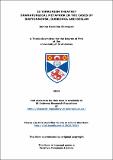Files in this item
Is terrorism theatre? : dramaturgical metaphor in the cases of Budyonnovsk, Dubrovka and Beslan
Item metadata
| dc.contributor.advisor | Fierke, K. M. (Karin M.) | |
| dc.contributor.author | Skrzypek, Janka | |
| dc.coverage.spatial | 234 p. | en_US |
| dc.date.accessioned | 2013-06-26T13:41:11Z | |
| dc.date.available | 2013-06-26T13:41:11Z | |
| dc.date.issued | 2013 | |
| dc.identifier | uk.bl.ethos.574842 | |
| dc.identifier.uri | https://hdl.handle.net/10023/3815 | |
| dc.description.abstract | This thesis is about terrorism metaphorically conceptualised as drama, theatre, spectacle and performance. It focuses on terrorism as a process of communication aimed at manipulating political attitude and behaviour. Even though it is terrorist actors who usually initiate that communication, various audiences play an important part in it, too. Not only do they receive and interpret the terrorist message, but they also have an impact on the content of that message and how it is transmitted. What attests to an important role of audience in terrorism is that in order for terrorism to work, those watching – the audience – need to change their behaviour to suit the political goals of terrorists. Arguably, if it were not for the people who alter their political behaviour as a result of having been terrorized, terrorism would not work, not to mention succeed. Another reason why there can be no terrorism without an audience is because the necessary presence of an audience is exactly what differentiates terrorism from other forms of political violence, such as war, secret killings or torture. While, at least for the time being, terrorism research remains “actor-focused” (Hülsse and Spencer, 2008), there is clearly a need to make it more “audience-focused”, to reflect the importance of the audience in terrorism, as highlighted above. This thesis examines the extent to which this can be achieved using the metaphors of drama, theatre, spectacle and performance. By applying the four dramaturgical metaphors to the terrorist attacks in Budyonnovsk, Dubrovka and Beslan, it investigates the potential of the metaphors to enhance the understanding of the dynamics between terrorism and counter-terrorism as well as the interplay between their respective actors and audiences. | en_US |
| dc.language.iso | en | en_US |
| dc.publisher | University of St Andrews | |
| dc.rights | Creative Commons Attribution-NonCommercial-NoDerivs 3.0 Unported | |
| dc.rights.uri | http://creativecommons.org/licenses/by-nc-nd/3.0/ | |
| dc.subject | Terrorism as drama | en_US |
| dc.subject | Terrorism as theatre | en_US |
| dc.subject | Terrorism as spectacle | en_US |
| dc.subject | Terrorism as performance | en_US |
| dc.subject | The Russo-Chechen conflict | en_US |
| dc.subject | Budyonnovsk | en_US |
| dc.subject | Dubrovka | en_US |
| dc.subject | Beslan | en_US |
| dc.subject.lcc | HV6431.S68 | |
| dc.subject.lcsh | Terrorism--Social aspects | en_US |
| dc.subject.lcsh | Drama--Techniques | en_US |
| dc.subject.lcsh | Audiences | en_US |
| dc.subject.lcsh | Terrorism--Russia (Federation) | en_US |
| dc.subject.lcsh | Chechn︠i︡a (Russia)--History--Civil War, 1994- | en_US |
| dc.title | Is terrorism theatre? : dramaturgical metaphor in the cases of Budyonnovsk, Dubrovka and Beslan | en_US |
| dc.type | Thesis | en_US |
| dc.type.qualificationlevel | Doctoral | en_US |
| dc.type.qualificationname | PhD Doctor of Philosophy | en_US |
| dc.publisher.institution | The University of St Andrews | en_US |
This item appears in the following Collection(s)
Except where otherwise noted within the work, this item's licence for re-use is described as Creative Commons Attribution-NonCommercial-NoDerivs 3.0 Unported
Items in the St Andrews Research Repository are protected by copyright, with all rights reserved, unless otherwise indicated.


